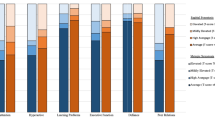Abstract
Methods
Psychosocial functioning was examined in 13 children who had undergone surgical treatment for intractable epilepsy. The ratings of each child's social, emotional and behavioural problems were obtained via parent and teacher reports made an average of 2 years post-operatively.
Results
Parents viewed their children as having greater social difficulties than reported in standardisation samples. Although the overall level of difficulty fell below clinically significant cut-offs, the proportion of children who were rated as having clinically significant levels of difficulties approached significance. Teachers rated these children as displaying more symptoms of anxiety and depression, although the levels remained subclinical.
Discussion
These results are discussed in view of the complex interaction between neurological and environmental variables involved in social-emotional functioning following surgical treatment for epilepsy.
Similar content being viewed by others
References
Achenbach TM (1991) Child Behavior Checklist for ages 4–18. Department of Psychiatry, University of Vermont, Burlington
Adolphs R, Tranel D, Damasio AR (1998) The human amygdala in social judgment. Nature 393:470–474
Derry P, Chovaz CJ, McLachlan RS, Cummings A (1993) Learned resourcefulness and psychosocial adjustment following temporal lobectomy in epilepsy. J Soc Clin Psychol 12:454–470
Dorenbaum D, Cappelli M, Keene D, McGrath PJ (1985) Use of a child behavior checklist in the psychosocial assessment of children with epilepsy. Clin Pediatr 24:634–637
Engel J, Driver MV, Falconer MA (1975) Electrophysiological correlates of pathology and surgical results in temporal lobe epilepsy. Brain 98:129–156
Ellis N, Upton D, Thompson P (2000) Epilepsy and the family: a review of current literature. Seizure 9:22–30
Gashlan M, Loy-English I, Ventureyra E, Keene D (1999) Predictors of seizure outcome following cortical resection in pediatric and adolescent patients with medically refractory epilepsy. Childs Nerv Syst 15:45–51
Gilliam F, Wylie E, Kashden J, Faught E, Kotagal P, Bebin M, Wise M, Comair Y, Roawetz R, Kuzniecky R (1997) Epilepsy surgery outcome: comprehensive assessment in children. Neurology 48:1368–1374
Green JR, Pootrakul A (1982) Surgical aspects of the treatment of epilepsy during childhood and adolescence. Arizona Med 39:35–38
Hermann BP, Whitman S, Hughes JR, Melyn MM, Dell J (1988) Multietiological determinants of psychopathology and social competence in children with epilepsy. Epilepsy Res 2:51–60
Jalava M, Sillanpaa M, Camfield C, Camfield P (1997) Social adjustment and competence 35 years after onset of childhood epilepsy: a prospective controlled study. Epilepsia 38:708–715
Keene D, Higgins M, Ventureyra E (1997) Outcome and life prospects after surgical management of medically refractory epilepsy in patients under 18 years of age. Childs Nerv Syst 13:530–535
Keene D, Loy-English I, Ventureyra E (1998) Long term socio/economic outcome following surgical intervention in the treatment of refractory epilepsy in childhood and adolescence. Childs Nerv Syst 14:362–365
Keene D, Loy-English I, Ventureyra E (1998) Patient satisfaction with surgical treatment of refractory epilepsy done in childhood and early adolescence. Childs Nerv Syst 14:30–32
Kuehn SM, Keene DL, Richards P, Ventureyra E (2002) Are there changes in intelligence and memory functioning following surgery for the treatment for refractory epilepsy in childhood? Childs Nerv Syst 18:306–310
Meyer FB, Marsh WR, Laws EJ, Sharbrough FW (1986) Temporal lobectomy in children with epilepsy. J Neurosurg 64:371–376
Mitchell W (1994) Social outcome of childhood epilepsy: associations and mechanisms. Semin Pediatr Neurol 1:136–142
Rasio-Filho AA, Londero RG, Achaval M (2000) Functional activities of the amygdala: an overview. J Psychiatry Neurosci 25:14–23
Williams J, Griebel ML, Sharp GB, Boop FA (1998) Cognition and behavior after temporal lobectomy in pediatric patients with epilepsy. Pediatr Neurol 19:189–194
Author information
Authors and Affiliations
Corresponding author
Rights and permissions
About this article
Cite this article
Korneluk, Y.G., Kuehn, S.M., Keene, D.L. et al. Psychosocial functioning following surgical treatment for intractable epilepsy in childhood. Childs Nerv Syst 19, 179–182 (2003). https://doi.org/10.1007/s00381-003-0723-3
Received:
Revised:
Published:
Issue Date:
DOI: https://doi.org/10.1007/s00381-003-0723-3



